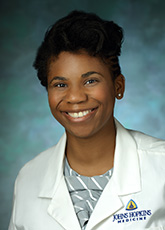Takeaway
Carefully observing our patients can lead to clinically relevant insights. Sometimes what seems inconsequential at first glance may be surprisingly significant.

Lifelong Learning in Clinical Excellence | November 22, 2021 | 4 min read
By Ekene Ojukwu, MD, Johns Hopkins Medicine
“What did you notice about Ms. L?” our attending asked.
Stripped of yellow contact precaution gowns with hands sanitized, we stood in a small ring outside Ms. L’s door. “We” included an attending, two medical students, an intern, and me, the resident. I let the silence rest between us as our team pondered the question. As the silence dragged on, I closed my eyes and did some breathing exercises, finding strange comfort in the sound of the hospital air conditioning. I resisted running through the differential for altered mental status, which was the reason Ms. L had been admitted. A timid voice broke my meditation.
“I noticed that she wasn’t really answering questions definitively. Whenever we asked something basic like whether she had abdominal pain or pain with urination, she said something like, ‘I don’t think I’ve ever thought about that,” said one of the medical students.
I nodded vigorously to affirm her observation, to show that I too had noticed this behavior. “And what did you think of that?” I probed.
“Hmm . . . I don’t know. At first, I thought that seemed like a reasonable answer. But then she was similarly vague with other questions where it didn’t seem like she should be.”
“Yes!” I exclaimed. “So, you’re noticing that her answers at first seemed to be appropriate, but then on further observation, those same types of answers no longer seemed appropriate.” I turned to the other members of the team. “What else did we notice?”
And just like that, more answers erupted from the group. Her untouched food on the side table. Her lack of eye contact. Her thinness and disheveled appearance. She didn’t have a cell phone with her. She didn’t speak beyond what we asked her. She didn’t volunteer any extra information. She appeared older than her stated age, with deeper wrinkles and perhaps slower movement than would be expected at that age of 60. Despite her disheveled appearance, she did not seem to have any particular odor. Her fingernails and toenails looked like they had been recently groomed until relatively recently. The mood in her room felt a little downcast.
We then asked ourselves more questions. Did she always talk like this? Was her lack of eye contact, or looking around the room, due to inattention, social awkwardness, or was she responding to internal stimuli? Why wasn’t she eating? Poor appetite? Dislike of the food? Concern that the food was being tampered with? How long hadn’t she been eating? Maybe a while given how thin she was? Did she have any history of eating disorders? Should we do a calorie count to document how much she was eating? Should we have someone present at her meals to see how she engaged with her food?
Such a simple activity. One question. It required no specialized knowledge. We were all on the same level, from medical students all the way up to attending. In that moment, we were all experts.
When I’ve had the honor of observing master clinicians, I’ve always been in awe of their ability to make note of seemingly inane pieces of information, home in on those facts, and unveil a secret treasure trove of data that then completely reoriented how the team thought about the care of a patient. The information would either illuminate the need for different diagnostics or highlight a new treatment strategy. We would go from just thinking about heart failure drug regimen to thinking about the way in which uncontrolled anxiety could be contributing to the incomplete management of that heart failure. All this just by stopping to notice, to pick up on the words buried amidst the more attention-grabbing medical narrative.
The medical learning environment is full of information, skills, emotions, and language that we all must navigate regularly. For the learner, it can feel overwhelming trying to deal with such a cognitive load while assessing how to fit into the hospital ecosystem. For the team leader, the overwhelming comes more with trying to decide what to teach, where to delegate, and how to balance the needs of the learners with the needs of the patients. As leaders in a learning environment, we want to impart so much that they’ve learned to our students and trainees, but other responsibilities, fatigue, emotional capacities, and biases can rob us of the presence of mind needed to meet learners where they are.
When the chaos of healthcare and life bleed into the sanctity of the learning space, I’m reminded by my role models that we can always teach the skill and value of noticing. With a simple question—what do/did we notice about . . .—we coach our teams and ourselves to bring to consciousness what we’ve seen without seeing. We show each other how naming what we see, hear, smell, touch, and feel within us allows us to be more present with our patients, more open to possibilities, more inquisitive, and more prepared to investigate and act. We value each other’s insights and set aside the fear of being wrong in ways that open doors for deeper knowledge and engagement. We give ourselves permission to see interrogate our biases and the biases of others to give the most clinically excellent care possible. And most importantly, we give ourselves permission to enjoy the wonder of medicine again.
So let’s take more time to stop and notice, to take a breath and debrief. That might be all it takes to change the learning space for learners, to stop a cycle of readmission for the patient, or to give some healing to ourselves.
This piece expresses the views solely of the author. It does not necessarily represent the views of any organization, including Johns Hopkins Medicine.

